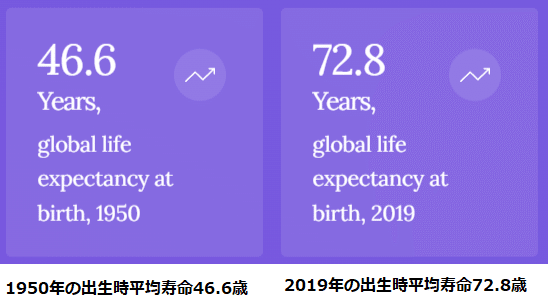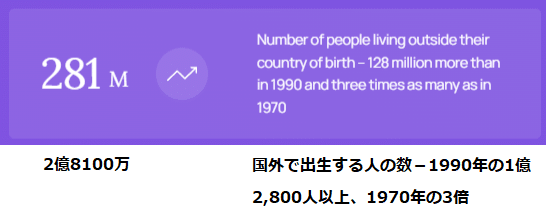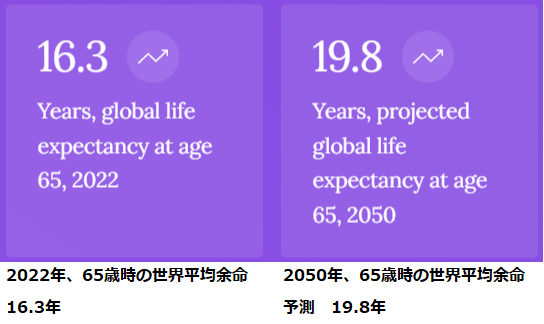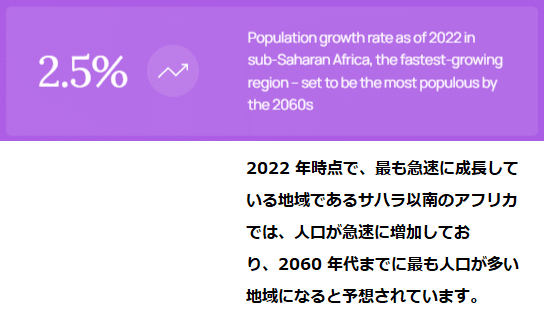
世界の人口 国連推計で80億人/国連レポート邦訳
8 Trends for a World of 8 Billion People
80億人の世界における8つのトレンド
01 Slowing growth
01 成長鈍化
The global population continues to grow, at 8 billion and counting. But after half a century of falling fertility, this growth is slowing down.
世界の人口は増え続け、80億人を数える。しかし、半世紀にわたる出生率の低下を経て、この成長は鈍化しつつある。
Global population change comes down to birth and death.
世界の人口変動は、誕生と死亡に帰結する。
The dynamics behind fertility and mortality are complex, but if there are more births than deaths, the population grows.
出生率と死亡率の背景にあるダイナミクスは複雑だが、出生数が死亡数を上回れば、人口は増加する。
While the balance depends on the context - including environmental, social, economic, and political factors - change follows certain patterns, known as the demographic transition.
バランスは環境、社会、経済、政治的要因などの状況によって異なるが、変化は人口動態の変遷として知られる一定のパターンに従っている。
This process began as improved nutrition, health care, living conditions, and education - and expanded choices, especially for women and girls - led to lower child mortality, longer lives, and fewer births per woman.
栄養、医療、生活環境、教育が改善され、特に女性や少女の選択肢が広がったことで、子どもの死亡率が下がり、寿命が延び、女性一人当たりの出生数が減るというプロセスが始まった。
At first, falling mortality drove spectacular population growth, peaking at 2.1% per year between 1962 and 1965. Between 1950 and 1987, the population doubled, from 2.5 to 5 billion.
当初は、死亡率の低下により、1962年から1965年にかけて年率2.1%のピークを迎えるなど、目覚しい人口増加を遂げた。1950年から1987年にかけて、人口は25億人から50億人へと倍増した。
But as fewer children were born from generation to generation, growth started to slow. In 2020, it fell below 1% per year for the first time since the 1950s.
しかし、世代を超えて子供が生まれなくなり、成長は鈍化し始めた。2020年には、1950年代以来初めて年率1%を割り込んだ。

Over the next few decades, population momentum will keep us growing. Past growth from previous generations with higher fertility - means that we have large and still rising numbers of women of reproductive age. Despite fewer births per woman, we'll continue to see more births than deaths.
今後数十年間は、人口が増加し続けるだろう。出生率の高い前世代からの過去の増加は、生殖年齢にある女性の数が多く、今も増え続けていることを意味する。女性一人当たりの出生数は減少しているが、出生数が死亡数を上回る状態が続くだろう。
Even if fertility fell to replacement level (about 2 births per woman) today in all countries where it's higher than that, enough children would be born to keep us growing through at least 2060.
仮に、現在、出生率がそれ以上であるすべての国で、出生率が置換水準(女性一人当たり約2人の出産)まで低下したとしても、少なくとも2060年まで成長を続けるのに十分な数の子供が生まれるだろう。
But as fertility continues to fall - and life expectancies rise-older people represent an ever-growing share of our population.
しかし、少子化が進み、平均寿命が延びる中で、高齢者が人口に占める割合は増え続けている。
As these large generations of older people begin to die, the number of deaths will outpace the number of births. Population growth will slow further and may decline.
これらの大規模な高齢者世代が死に始めると、死亡者数が出生者数を上回ります。人口増加はさらに減速し、減少する可能性がある。
We project that our population will peak at 10.4 billion in the 2080s and stay there through the end of the century.
私たちは、2080年代に人口が104億人でピークを迎え、今世紀末までその状態が続くと予測している。
The same overall patterns apply when we look at regions, countries, and areas - although a third factor, international migration, comes into play.
地域、国、エリア別に見ても、全体的に同じパターンが当てはまる。ただし、第三の要因として、国際的な移動が絡んでくる。
The demographic transition has happened at different rates in different parts of the world, with different environmental, social, economic, and political factors affecting the balance of births and deaths, in-migration, and out-migration.
人口動態の移行は、出生と死亡、入国と出国のバランスに影響を与える環境、社会、経済、政治的要因が異なるため、世界各地で異なる速度で起こっている。
Across countries, populations are growing at different rates.
国によって、人口増加のスピードは異なる。
Some are growing faster than the global average, and others slowing or even shrinking. Across this stunning diversity, the only constant changes.
世界平均を上回るスピードで成長しているものもあれば、減速しているもの、あるいは縮小しているものもあります。この驚くべき多様性の中で、唯一不変なのは変化だ。
02Fewer children
02子供の数が少ない
While fertility varies across regions and countries, rates are falling everywhere. And in some countries, populations are shrinking.
出生率は地域や国によって異なるが、どこの国でも低下している。また、人口が減少している国もある。
The global fertility rate - the average number of births per woman - has been falling for decades. Reductions in fertility are associated with factors including expanded opportunities for girls' and women's education and workforce participation, delayed marriage and childbearing, and increased access to contraception.
世界の出生率(女性一人当たりの平均出生数)は、数十年にわたり低下している。出生率の低下は、少女や女性の教育や労働参加の機会の拡大、結婚や出産の遅れ、避妊へのアクセス向上などの要因と関連している。
Back in 1950, global fertility stood at 5 births per woman. As of 2022, it's at 2.3, projected to fall to 2.1 by 2050.
1950年当時、世界の出生率は女性一人当たり5人でした。2022年現在、2.3人であり、2050年には2.1人にまで減少すると予測されている。
As relatively fewer children are born - while longer life expectancies drive growing populations at older ages - the share of children (ages 0-14) in the global population is declining.
平均寿命の延びによって高齢者人口が増加する一方で、出生する子どもの数は相対的に少なくなっており、世界人口に占める0〜14歳の子どもの割合は減少している。
Globally, we're getting close to replacement-level fertility - where in the long run a population no longer grows but maintains equal numbers from generation to generation. This rate depends on mortality and, at the level of countries or areas, also on migration. Given our low average mortality rates, the fertility rate for zero growth stands at about 2.1 births per woman.
世界的に見れば、人口置換水準に近づきつつある。つまり、長期的に見れば、人口はもはや増加することはなく、世代間で同数を維持する。この割合は死亡率に依存し、国や地域のレベルでは、移民にも依存する。平均死亡率の低さを考えると、ゼロ成長の場合の出生率は女性一人当たり約2.1人である。
Already, over 60% of people - up from 40% in 1990 - live in a country or area where fertility is below replacement level.
すでに、1990年の40%から60%以上の人々が、人口置換水準を下回る国や地域に住んでいる。
Even where it's high enough to sustain growth in sub-Saharan Africa, Oceania (except Australia and New Zealand), northern Africa, and western and southern Asia-it's still falling. Except in sub-Saharan Africa, it is expected to fall below replacement level in all regions by the end of the century.
サハラ以南のアフリカ、オセアニア(オーストラリアとニュージーランドを除く)、アフリカ北部、西・南アジアでは、プラス成長を維持できるほど高い水準にあっても、依然として低下しているのである。サハラ以南のアフリカを除くすべての地域で、今世紀末には人口が置換水準を下回ると予想されている。

In some low-fertility countries, populations are still growing because of population momentum. This is the case in India, which is 2023 will overtake China as the world's most populous country, despite fertility already below 2.1 births per woman, and falling.
低出生率の国の中には、人口の勢いに押されて人口がまだ増加している国もある。インドがそうである。出生率がすでに女性一人当たり2.1人を下回り、低下しているにもかかわらず、2023年には中国を抜いて世界で最も人口の多い国になるという。
In other countries, populations are shrinking after decades of low fertility - exacerbated, in some cases, by high levels of emigration. In 17 countries of Eastern Europe, both factors have contributed to population decline since 1990.
他の国々では、数十年にわたる少子化の後、人口が減少しており、場合によっては、高いレベルの移民がそれを悪化させている。東欧の17カ国では、1990年以降、両方の要因が人口減少に寄与している。
Looking ahead, more countries, especially in Southern Europe and East Asia, are beginning to see their populations decline – including China, projected to start shrinking as early as 2023. Between 2022 and 2050, the populations of 61 countries are expected to shrink by over 1%. Among them, Bulgaria, Latvia, Lithuania, Serbia, and Ukraine may see reductions of 20% or more.
今後、南ヨーロッパや東アジアを中心に、人口が減少に転じる国が増え、早ければ2023年に人口減少が始まると予測される中国もその一つです。2022年から2050年の間に、61カ国の人口が1%以上減少すると予想されている。その中でも、ブルガリア、ラトビア、リトアニア、セルビア、ウクライナは20%以上の減少が予想される。
03Longer lives
03長寿命化
Life expectancy is rising globally, but huge disparities persist.
平均寿命は世界的に伸びていますが、大きな格差が存在している。
Across the world, people are living longer. In 2019, global life expectancy at birth stood at 72.8 years, up almost 9 years since 1990 - and it's projected to rise to 77.2 years by 2050.
世界中で、人々は長生きしている。2019年、世界の出生時平均寿命は72.8歳で、1990年から約9年延びており、2050年には77.2歳まで延びると予測されている。
Life expectancy refers to the average number of years a person of a particular age can expect to live, given overall death rates in their population. We typically measure it at birth and at age 65.
平均寿命とは、人口全体の死亡率を考慮した上で、ある年齢の人が平均何年生きられるかを示すものだ。通常、出生時と65歳時に測定される。
Life expectancy at birth has been rising since the 1950s in all regions, especially as death rates from infectious diseases have fallen. There have been measurable setbacks - related to the 1957 influenza pandemic and, more recently, HIV/AIDS and COVID-19.
1950年代以降、すべての地域で出生時平均寿命は伸びており、特に感染症による死亡率は低下している。1957年のインフルエンザの大流行や、最近ではHIV/AIDSやCOVID-19など、目に見えて後退しているものもある。
But overall, the trend has been towards lower mortality - including lower under-five mortality - and longer lives, linked to factors including better nutrition, health care, and living conditions.
しかし、全体としては、5歳未満児の死亡率の低下など死亡率の低下と、栄養、医療、生活環境の改善などの要因による長寿化の傾向にある。
But the extent to which these conditions hold varies greatly across the world, both among countries and within them. While mortality has fallen in all regions, there are significant disparities.
しかし、これらの条件がどの程度維持されているかは、世界各国間でも国内でも大きく異なっている。死亡率はすべての地域で低下しているが、大きな格差がある。
In low-income countries, life expectancy at birth is about 63, or nearly 10 years below the global average.
低所得国では、出生時の平均寿命は約63歳で、世界平均より10歳近くも低いのである。
Disparities in under-five mortality account for a large part of the gap. A child born in a low-income country is over 13 times more likely to die before age 5 than one born in a high-income country. Higher mortality rates also reflect high maternal mortality and, in some countries, violence, conflict, and the continuing impacts of HIV.
5歳未満児の死亡率の格差がその大きな部分を占めている。低所得国で生まれた子どもが5歳未満で死亡する確率は、高所得国で生まれた子どもに比べて13倍以上です。死亡率の高さは、妊産婦死亡率の高さや、国によっては暴力、紛争、HIVの影響が続いていることも反映している。

The gap in life expectancy at birth can be as much as 33.4 years.
出生時の平均寿命の差は33.4歳にもなる。
While a newborn in Australia, Hong Kong SAR, Macao SAR, or Japan - where it's highest - can expect to live 85 or more years, a newborn in the Central African Republic, Chad, Lesotho, or Nigeria - the countries with the lowest life expectancies - can expect to live less than 54 years.
平均寿命が最も長いオーストラリア、香港特別行政区、マカオ特別行政区、日本の新生児は85年以上生きることが期待できるが、平均寿命が最も短い中央アフリカ共和国、チャド、レソト、ナイジェリアの新生児は54年以下しか生きられないと予想される。
Looking ahead, the gaps are narrowing, as life expectancy rises in many countries that today have lower life expectancies, while the rise in life expectancy slows in today's low-mortality countries.
将来的には、現在平均寿命が低い多くの国々で平均寿命が延び、一方、現在の低死亡率の国々では平均寿命の延びが鈍化し、格差は縮小していくだろう。
Still, the gaps are not narrowing fast enough. In 2050, life expectancy at birth in low-income countries is projected to be about 8.4 years less than the global average. And a baby born in the countries with the lowest life expectancies today may still live an average of 31.8 years less than a baby born in those with the highest life expectancies.
それでも、格差はなかなか縮まらない。2050年には、低所得国の出生時平均寿命は世界平均より約8.4年短くなると予測されている。また、現在最も平均寿命の短い国で生まれた赤ちゃんは、最も平均寿命の長い国で生まれた赤ちゃんより平均31.8年短く生きることになるかもしれないと言われている。
04People on the move
04移動する人々
International migration is reshaping populations. In some low-fertility countries, immigration sustains population growth - while in others, emigration compounds population decline.
国際的な移民が人口の形を変えつつある。低出生率の国では、移民が人口増加を支えているが、一方で移民が人口減少を招いている国もある。
At the level of regions, countries, and areas, international migration shapes population change, alongside fertility, and mortality. It's harder to project than the other two, because of incomplete data and migration patterns that can change rapidly depending on what's going on across the world.
地域、国、地区のレベルでは、国際移住は出生率や死亡率と並んで人口の変化を形成している。国際移住は、データが不完全であることや、世界各地の情勢によって移住のパターンが急速に変化することから、他の2つよりも予測が困難である。
While nearly 29 out of every 30 people stay in their country of birth, the number of people moving across borders is rising.
30人に29人近くが生まれた国に留まる一方で、国境を越えて移動する人の数は増えている。
It's expected to rise further - including as a result of the worsening impacts of climate change.
また、気候変動の影響もあり、今後さらに増加することが予想される。
As of 2020, an estimated 281 million people lived outside their country of birth - 128 million more than in 1990 and three times as many as in 1970. Nearly two-thirds were labor migrants. As of the end of 2021, international migrants also included 31.7 million refugees and asylum seekers.
2020年時点で、推定2億8100万人が生まれた国以外で生活している。これは1990年より1億2800万人多く、1970年の3倍である。ほぼ3分の2が労働移民である。2021年末時点で、国際移民には3170万人の難民・庇護希望者も含まれている。
Between 2010 and 2021, 40 countries and areas saw net inflows of over 200,000 migrants each - and in 17 of them, over 1 million each.
2010年から2021年の間に、40の国と地域でそれぞれ20万人を超える移民の純流入があり、そのうち17の国ではそれぞれ100万人を超えている。

In 2020, Türkiye hosted the largest number of refugees and asylum seekers - almost 4 million Jordan hosted 3 million, the State of Palestine, 2 million, and Colombia, 1.8 million. Germany, Lebanon, Pakistan, Sudan, Uganda, and the United States also hosted large numbers of refugees, asylum seekers and other displaced people.
2020年、最も多くの難民・庇護希望者を受け入れたのはトルコで、約400万人 ヨルダンは300万人、パレスチナ国は200万人、コロンビアは180万人を受け入れました。ドイツ、レバノン、パキスタン、スーダン、ウガンダ、米国も大量の難民、庇護希望者、その他の避難民を受け入れている。
Ten countries saw net outflows of over 1 million during the same period. 16.5 million people left Pakistan, 3.5 million left India, 2.9 million left Bangladesh, 1.6 million left Nepal and 1 million left Sri Lanka. Most of these emigrants left temporarily, in pursuit of work.
同期間に100万人を超える純流出があったのは10カ国。パキスタンは1650万人、インドは350万人、バングラデシュは290万人、ネパールは160万人、スリランカは100万人が流出している。これらの移民のほとんどは、仕事を求めて一時的に出国している。
Emigration from other countries has been driven by insecurity and conflict. As of the end of 2021, 6.8 million people had left Syria as refugees, while 4.6 million had left Venezuela, 2.7 million, in Afghanistan: 2.4 million in South Sudan; and 1.2 million, in Myanmar.
他国からの移住は、不安や紛争が原因となっている。2021年末時点で、680万人が難民としてシリアを離れ、460万人がベネズエラ、270万人がアフガニスタン、240万人が南スーダン、120万人がミャンマーを離れています。
Staggering numbers of people may be displaced over a short time between 24 February and 19 October 2022, for instance, an estimated 7.7 million people fled Ukraine, crossing into neighboring countries, including Poland and Moldova.
2022年2月24日から10月19日までの短期間に驚異的な数の人々が避難する可能性がある。例えば、推定770万人がウクライナから脱出し、ポーランドやモルドバなどの周辺国に渡っていったと言われている。
For some countries, migration makes a critical difference in terms of population change - sustaining growth or compounding decline.
国によっては、移民が人口の変化、つまり成長を維持するのか、あるいは減少を助長するのか、という点で決定的な違いを生むことがある。
In high-income countries, which have seen low fertility for decades, migration was a bigger factor contributing to population growth than births during the period 2000-2020-and it will be the sole driver of population growth in the coming decades.
数十年にわたり少子化が続いている高所得国では、2000年から2020年の間、出生数よりも移住が人口増加に大きく寄与しており、今後数十年間は移住が人口増加の唯一の原動力となるであろう。
In other countries, including in Eastern Europe, more people are leaving than are coming in - and together with falling fertility, this high net emigration is driving population decline.
東欧を含む他の国々では、流入する人口よりも流出する人口の方が多く、出生率の低下とともに、この高い純移動が人口減少を引き起こしている。
05Aging populations
05人口の高齢化
As fertility declines and life expectancy rises, the global population is aging fast.
少子化と平均寿命の伸びにより、世界の人口は急速に高齢化が進んでいる。
As a global population, we're getting older, and it's happening faster than ever. Between 1950 and 1990, the share of people 65 and over in the population rose from about 5% to about 6%. As of 2022, it stands at nearly 10%, projected to rise to 16% by 2050.
世界的に見ても、私たちは高齢化が進んでおり、そのスピードはかつてないほど速くなっています。1950年から1990年の間に、人口に占める65歳以上の割合は約5%から約6%に上昇しました。2022年現在、その割合は10%近くに達し、2050年には16%に上昇すると予測されている。
In many countries, large generations of children who were born in past decades of sustained high fertility are now aging. In others, incremental improvements in survival across several generations are driving the growth of older populations.
多くの国では、過去数十年間、高い出生率が維持された時代に生まれた多くの子どもたちが、現在、高齢化している。また、数世代にわたる生存率の漸進的な向上が、高齢者人口の増加を促進している国もある。
Global life expectancy at age 65- the average number of additional years a 65-year-old person can expect to live - is rising. It's now at 16.3 years and was at 17.5 before COVID-19 hit older populations disproportionately hard. By 2050, it's projected to rise to 19.8 years, as deaths from noncommunicable diseases like cardiovascular disease or diabetes fall further.
世界の65歳平均余命(65歳の人があと何年生きられるかの平均値)は伸びています。現在、平均寿命は16.3歳で、COVID-19が高齢者層に不釣り合いに大きな打撃を与える前は17.5歳でした。2050年には、心血管疾患や糖尿病などの非感染性疾患による死亡がさらに減少するため、19.8年まで上昇すると予測されている。
Because fertility has been falling at the same time as people have been living longer, the age structure of the population is shifting. In 2018, for the first time ever, people aged 65+outnumbered children under 5.
長寿化と同時に出生率が低下しているため、人口の年齢構成は変化しています。2018年には、史上初めて65歳以上の人が5歳以下の子供を上回った。
By 2050, the number of people aged 65+ will be over twice the number of children under 5, and about the same as the number of children under 12.
2050年には、65歳以上の人口は5歳以下の子どもの数の2倍以上、12歳以下の子どもの数とほぼ同じになると言われている。

Different regions are aging at different rates.
地域によって高齢化のスピードは異なる。
Europe and northern America have the oldest populations, with almost 19% of people aged 65+, followed by Australia and New Zealand, with 16.6%. By 2050, 1 in 4 people in Europe and northern America will be 65 or older.
ヨーロッパと北アメリカは、65歳以上の人口が約19%と最も高く、次いでオーストラリアとニュージーランドの16.6%となっています。2050年には、ヨーロッパと北アメリカでは4人に1人が65歳以上の高齢者になると言われている。
All other regions will see their share of people aged 65+rise quickly, too-for example, from 9% in 2022 to 19% in 2050 in Latin America, and from 13% to 26% in eastern and southeastern Asia.
他のすべての地域でも、65 歳以上の人口の割合が急速に上昇する。たとえば、ラテンアメリカでは 2022 年の 9% から 2050 年には 19% に、東アジアと東南アジアでは 13% から 26% に増加する。
But because some regions are still relatively young, people aged 65+ will continue to make up much smaller shares of their populations - despite the growth of over 3% per year among this age group. In sub-Saharan Africa, the region with the youngest population, the share of people 65+ is projected to grow from 3% in 2022 to 5% in 2050.
しかし、地域によってはまだ比較的若いため、65歳以上の人口が占める割合は、この年齢層が年3%以上増加しているにもかかわらず、今後もずっと小さいままであろうと思われる。最も人口の少ないサハラ以南のアフリカでは、65歳以上の人口比率は2022年の3%から2050年には5%に増加すると予測されている。
06Women outliving men
06女性が男性より長生きする
More boys than girls are born worldwide, but women outlive men nearly everywhere. The result is a global population in which men only slightly outnumber women.
世界では女児より男児の方が多く生まれているが、女性はほぼすべての地域で男性より長生きしている。その結果、世界の人口は男性が女性よりわずかに多いだけになっています。
Globally, nearly 106 boys are born for every 100 girls. This is within the biologically normal range of 102-106. (Anything above 106 would indicate that gender-biased sex selection is taking place.)
世界的に見ると、女の子100人に対して男の子は106人近く生まれている。これは生物学的に正常な範囲である102-106の範囲内である。(106を超えると、性別に偏った性選択が行われていることになる)。
While born in greater numbers, boys are more likely to die during infancy and early childhood than girls, from conditions such as birth complications and infections. As of 2020, under-five mortality among boys was estimated at 39 deaths per 1,000 live births, versus 34 among girls.
男児は、出生数が多い反面、出産時の合併症や感染症などで、乳幼児期や幼児期に死亡する確率が女児よりも高い。2020年時点で、男子の5歳未満児死亡率は1,000人出生あたり39人であるのに対し、女子は34人と推定されている。

Throughout adolescence and adulthood, males die in higher numbers because of factors like a greater likelihood of risky behaviors, weaker immune systems, and higher risks of cardiovascular disease at younger ages.
思春期から成人期にかけて、危険な行動をとる可能性が高い、免疫力が弱い、若年で心血管疾患のリスクが高いなどの要因から、男性の死亡者数が多くなっているのです。
As a result, women outlive men on average. This gap in life expectancy is not unique to humans. It stems from a complex interaction of biological factors (some linked to males having just one X chromosome) and social or behavioral ones.
その結果、女性は平均して男性より長生きしている。この平均寿命の差は、人類に限ったことではありません。生物学的要因(X染色体を1本しか持たない男性に関連するものもある)と社会的・行動的要因の複雑な相互作用から生じているのである。
The female survival advantage holds despite the substantial impacts of gender inequality on girls and women's survival and health, including a greater likelihood of neglect during childhood, driven by the discriminatory social norm of son preference, and higher rates of poverty and hunger throughout life.
この女性の生存の優位性は、息子優先という差別的な社会規範によって幼少期に育児放棄される可能性が高く、生涯を通じて貧困や飢餓の割合が高いなど、ジェンダー不平等が少女や女性の生存と健康に大きな影響を与えるにもかかわらず、維持されている。
While women have higher rates of illness overall, they are more likely to survive them.
女性は全体的に病気にかかる率が高い一方で、それを生き延びる率も高い。
Where there are high rates of maternal mortality, though, this survival advantage is reduced.
しかし、母体死亡率が高いところでは、この生き延びるための利点は減少する。
Women's life expectancy at birth is 5.4 years longer than men's, on average. The gap ranges from 2.9 years in Australia and New Zealand to 7 years in Latin America and the Caribbean.
女性の出生時平均余命は、男性より平均5.4年長い。その差は、オーストラリアとニュージーランドの2.9歳から、ラテンアメリカとカリブ海諸国の7歳までと幅があります。

Over time, the gap has varied across countries and regions, shrinking in Europe and North America as well as Australia and New Zealand, but widening in Asia. In sub-Saharan Africa, it was on the rise until disproportionate female mortality from HIV/AIDS in the late 1990s-mid 2000s reduced it-though since COVID, it has now increased slightly.
時間の経過とともに、格差は国や地域によって異なり、ヨーロッパ、北米、オーストラリア、ニュージーランドでは縮小しているが、アジアでは拡大している。サハラ以南のアフリカでは、1990年代後半から2000年代半ばにかけてHIV/AIDSによる女性の死亡率が不均衡になるまで上昇を続けていたが、COVID以降、わずかに上昇を続けている。
With an average life expectancy at age 65 of 18.8 years, compared to 15.9 for men, women outnumber men in nearly all older populations, making up 55.7% of people aged 65+ globally in 2022. This gap increased slightly because of higher COVID-19 mortality among men but is projected to decline by 2050, to 54.4% of women, as men enjoy better health and lower mortality.
65歳の平均寿命が18.8歳であるのに対し、男性は15.9歳で、ほぼすべての高齢者人口において女性が男性を上回り、2022年には世界の65歳以上の人口の55.7%を占めている。この差は、男性のCOVID-19による死亡率が高いためにわずかに増加しましたが、男性がより良い健康と低い死亡率を享受しているため、2050年までに減少し、女性比は54.4%になると予測されている。
In the overall population, men outnumber women, but only slightly-50.3% versus 49.7%, respectively, as of 2022. By 2050, the numbers of women and men are projected to be equal.
全人口では、2022年時点で男性が50.3%、女性が49.7%と、わずかながら女性より多くなっています。2050年には男女同数になると予測されています。
07Two pandemics
07二つのパンデミック
COVID-19 had a measurable impact on mortality. For regions hardest hit by the earlier HIV/AIDS pandemic, it erased hard-won gains in life expectancy.
COVID-19は死亡率に顕著な影響を与えた。HIV/AIDSの流行で最も大きな打撃を受けた地域では、せっかく伸びてきた平均寿命が帳消しになった。
Over just two years, the COVID-19 pandemic had a measurable impact on the population, especially on mortality.
COVID-19のパンデミックは、わずか2年の間に、人口、特に死亡率に測定可能な影響を及ぼした。
In 2020 and 2021, it led to 14.9 million more deaths than expected based on previous years' estimates. Three times the officially reported number of COVID-19 deaths, this number includes indirectly related deaths, such as deaths from other health conditions - including HIV/AIDS - for which people couldn't get treatment or preventive care. Of these deaths, over half were in lower-middle-income countries.
2020年と2021年には、前年の推計に基づく予想を上回る1490万人の死亡につながった。COVID-19の公式報告死者数の3倍で、この数には、治療や予防医療を受けられなかった他の健康状態-HIV/AIDSを含む-による死など、間接的な関連死が含まれている。これらの死者のうち、半数以上は低中所得国での死者だった。

Between 2019 and 2021, life expectancy at birth fell by 1.7 years globally.
2019年から2021年にかけて、出生時平均寿命は世界的に1.7年減少した。
The largest declines were in central and southern Asia (-2.3 years) and Latin America and the Caribbean (-1.5 years). Among countries, Bolivia, Botswana, Lebanon, Mexico, Oman, and the Russian Federation saw COVID-related declines of more than 4 years.
減少幅が大きかったのは、中央・南アジア(-2.3年)と中南米・カリブ海諸国(-1.5年)であった。国別では、ボリビア、ボツワナ、レバノン、メキシコ、オマーン、ロシア連邦でCOVID関連の減少が4年以上となった。
While estimates show life expectancy already at pre-COVID levels in countries with high vaccine prevalence, those with low vaccine prevalence can expect a time lag of 13 years. Only 1 in 4 people in low-income countries have had at least one vaccine dose, compared to 3 in 4 in high-income countries.
ワクチン普及率の高い国では、平均寿命がすでにCOVID以前の水準に達しているとの推計がある一方で、ワクチン普及率の低い国では13年のタイムラグが予想されます。低所得国では4人に1人しか少なくとも1回のワクチン接種を受けていないのに対し、高所得国では4人に3人が受けている。
COVID-19 hit a population already bearing the imprint of HIV/AIDS. Both pandemics have been characterized by unequal access to lifesaving tools and resources.
COVID-19は、すでにHIV/AIDSの影響を受けている人たちを直撃しました。両大流行とも、救命手段や資源へのアクセスが不平等であることが特徴であった。
For some regions, there's been a significant cumulative impact.
地域によっては、大きな累積的影響を受けているところもある。

Worldwide, AIDS has killed over 40 million people since 1981, or nearly half of those infected with HIV. While HIV infection was initially a death sentence, the introduction of antiretroviral therapy (ART) cut AIDS deaths by 68%.
世界では1981年以降、エイズによって4000万人以上が死亡しており、これはHIV感染者の約半数にあたります。当初、HIV感染は死の宣告であったが、抗レトロウイルス療法(ART)の導入により、エイズによる死亡者数は68%減少した。
But while these lifesaving treatments were developed in the mid-1990s, they were unavailable to people in poorer countries - including in sub-Saharan Africa, where the pandemic's toll was and continues to be heaviest - until the early/mid-2000s.
しかし、これらの救命処置は1990年代半ばに開発されたものの、パンデミックの犠牲者が最も多かったサハラ以南のアフリカを含む貧しい国々の人々には、2000年代初頭から半ばまで利用することができなかった。
HIV―AIDS cost southern Africa, the hardest-hit subregion, two decades of potential improvements in survival rates. Between 1990 and 2005, life expectancy at birth fell from 63.1 years to 53.1. While it returned to its 1990 level by 2015 and increased to 65.5 years in 2019, COVID-19 erased those gains, bringing life expectancy back down to 61.8 years as of 2022.
HIV-AIDSは、最も大きな被害を受けたアフリカ南部地域において、20年間にわたり改善される可能性のあった生存率を犠牲にした。1990年から2005年の間に、出生時平均寿命は63.1歳から53.1歳に減少した。2015年には1990年の水準に戻り、2019年には65.5歳まで伸びたものの、COVID-19はその成果を消し去り、2022年の時点で平均寿命は61.8歳まで下がっている。
08Shifting centers
08中心のシフト
Regions are growing at different rates, shifting the geographical distribution of the global population.
地域によって成長のスピードが異なるため、世界人口の地理的分布が変化している。
As of 2022, over half the world's people live in Asia. The world's two most populous regions are eastern and southeastern Asia, home to 2.3 billion people, and central and southern Asia, with 2.1 billion.
2022年現在、世界の人口の半分以上がアジアに住んでいます。世界で最も人口の多い地域は、23億人の東・南東アジアと21億人の中央・南アジアです。
India and China, each with over 1.4 billion people, make up most of the population in these two regions. China's population is no longer growing and may start declining as early as 2023 - when India, still growing at 0.7% per year, is set to surpass it as the world's most populous country.
インドと中国は、それぞれ14億人以上の人口を抱え、この2つの地域の人口の大半を占めています。中国の人口はもはや増加することはなく、早ければ2023年には減少に転じるかもしれない。このとき、年率0.7%の成長を続けるインドが、中国の人口を抜いて世界一の国になると予想されている。
In eastern and southeastern Asia, fertility has seen a rapid decline since the 1960s, reaching replacement level in the early 1990s - slowing the region's growth to just 0.2% per year as of 2022. Its population is projected to peak by the mid-2030s, at about 2.4 billion people.
東・南東アジアでは、1960年代から急速に少子化が進み、1990年代前半には人口置換水準に達し、2022年時点では年率0.2%の成長率にとどまっている。この地域の人口は2030年代半ばにピークを迎え、約24億人になると予測されている。
In central and southern Asia, fertility declined more slowly, and the population is growing at 0.9% per year. The region is expected to become the world's most populous by 2037, and to keep growing until it peaks at about 2.7 billion around 2072.
中央アジアと南アジアでは、出生率の低下がより緩やかで、人口は年率0.9%で増加している。2037年には世界で最も人口の多い地域になり、2072年頃に約27億人のピークを迎えるまで成長を続けると予想されている。

Meanwhile, sub-Saharan Africa has been the fastest-growing region since the 1980s. Its growth rate peaked at 3% per year in 1978, declining slightly since then to 2.5% in 2022-still almost triple the current global average of 0.8%.
一方、サハラ以南のアフリカは、1980年代以降、最も成長率の高い地域となっている。その成長率は1978年の年率3%をピークにやや低下し、2022年には2.5%と、現在の世界平均0.8%のほぼ3倍となっている。
Sub-Saharan Africa's population is projected to almost double between 2022 and 2050 - accounting for more than half of global population growth in that period and reaching over 2 billion by the late 2040s.
サハラ以南のアフリカの人口は、2022年から2050年の間にほぼ倍増すると予測されており、この期間の世界の人口増加の半分以上を占め、2040年代後半には20億人を超えるとされている。
By the late 2060s, sub-Saharan Africa is projected to become the most populous region and could see its population reach 3.44 billion by 2100.
2060年代後半には、サハラ以南のアフリカは最も人口の多い地域になると予測され、2100年には34億4千万人に達する可能性がある。

Latin America and the Caribbean, which quadrupled in size between 1950 and 2022 and are currently growing at 0.7% per year, will peak around 2056, and then begin to decline, though their share of the world population will decline only slightly.
1950年から2022年の間に4倍になり、現在年率0.7%で成長しているラテンアメリカ・カリブ海諸国は、2056年頃にピークを迎え、その後減少に転じるが、世界人口に占める割合はわずかな減少にとどまると考えられる。
The populations of Northern Africa and Western Asia, Oceania, Australia, and New Zealand will continue to grow through the end of the century, slightly increasing or maintaining their shares of the global population.
北アフリカと西アジア、オセアニア、オーストラリア、ニュージーランドの人口は今世紀末まで増加を続け、世界人口に占める割合はわずかに増加するか、維持されるであろう。
Europe and Northern America, which in 1960 accounted for over a quarter of the world's people, have been growing at a rate of less than 1% per year since the mid1960s and is now close to zero growth.
1960年には世界人口の4分の1以上を占めていたヨーロッパと北アメリカは、1960年代半ばから年率1%以下の成長を続け、現在ではゼロ成長に近い状態である。
As of 2022, its population, at 1.14 billion, is about the same as that of sub-Saharan Africa, as is its share of the global population, at about 14%. But projections show that the population of Europe and Northern America will start declining by 2038, with its share falling to about 11% by 2058.
2022年時点で、その人口は11.4億人とサハラ以南のアフリカとほぼ同じであり、世界人口に占める割合も約14%である。 2022年時点の人口は14億人で、サハラ以南のアフリカとほぼ同じであり、世界人口に占める割合も約14%である。しかし、予測によると、ヨーロッパと北アメリカの人口は2038年までに減少に転じ、2058年にはそのシェアは約11%に落ちるという。
国連ホームページより、機械翻訳を中心に、手直しを加えて翻訳しております。
未来創造パートナー 宮野宏樹
自分が関心があることを多くの人にもシェアすることで、より広く世の中を動きを知っていただきたいと思い、執筆しております。もし、よろしければ、サポートお願いします!サポートしていただいたものは、より記事の質を上げるために使わせていただきますm(__)m
